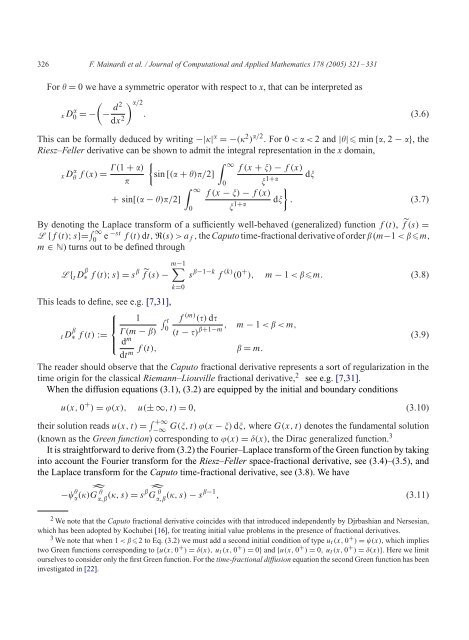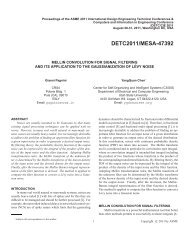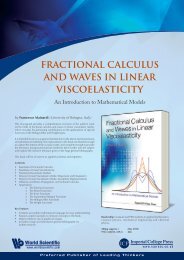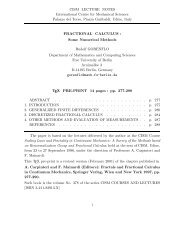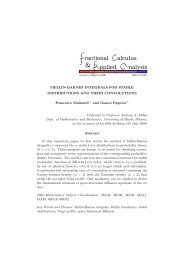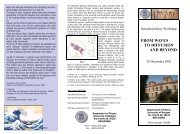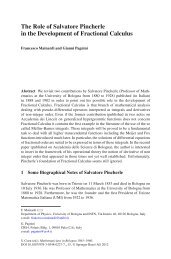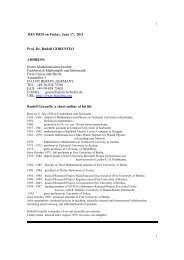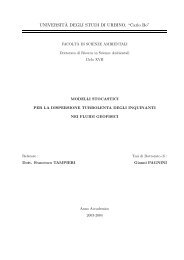326 F. Ma<strong>in</strong>ardi et al. / Journal of Computational and Applied Mathematics 178 (2005) 321–331 For = 0 we have a symmetric operator with respect to x, that can be <strong>in</strong>terpreted as xD 0 =− − d2 dx2 /2 . (3.6) This can be formally deduced by writ<strong>in</strong>g −|| =−( 2 ) /2 . For 0 < < 2 and || m<strong>in</strong> {, 2 − }, the Riesz–Feller derivative can be shown to admit the <strong>in</strong>tegral representation <strong>in</strong> the x doma<strong>in</strong>, xD (1 + ) ∞ f(x + ) − f(x) f(x) = s<strong>in</strong> [( + )/2] 0 1+ d ∞ + s<strong>in</strong>[( − )/2] d . (3.7) 0 f(x − ) − f(x) 1+ By denot<strong>in</strong>g the Laplace transform of a sufficiently well-behaved (generalized) function f(t), f(s) = L {f(t); s}= ∞ 0 e −st f(t) dt,R(s)>af , the Caputo time-<strong>fractional</strong> derivative of order (m−1 < m, m ∈ N) turns out to be def<strong>in</strong>ed through L{ tD ∗ f(t); s}=s m−1 f(s) − k=0 s −1−k f (k) (0 + ), m − 1 < m. (3.8) This leads to def<strong>in</strong>e, see e.g. [7,31], tD ⎧ ⎪⎨ 1 t f ∗ f(t) := (m − ) 0 ⎪⎩ (m) () d , +1−m (t − ) d m−1 <
F. Ma<strong>in</strong>ardi et al. / Journal of Computational and Applied Mathematics 178 (2005) 321–331 327 so that G , (,s)= s−1 s + (). (3.12) By us<strong>in</strong>g the known scal<strong>in</strong>g rules for the Fourier and Laplace transforms, we <strong>in</strong>fer without <strong>in</strong>vert<strong>in</strong>g the two transforms, G , (x, t) = t−K , (x/t ), = /, (3.13) where the one-variable function K , is the reduced Green function and x/t is the similarity variable. We note from G, (0,s)= 1/s ⇐⇒ G , (0,t)= 1, the normalization property +∞ −∞ G , (x, t) dx = +∞ −∞ and, from () = (−) = − (−), the symmetry relation K , K , (x) dx = 1, (3.14) (−x) = K−(x), (3.15) , which allows us to restrict our attention to x>0. When = 2( = 0) and = 1 the <strong>in</strong>version of the Fourier–Laplace transform <strong>in</strong> (3.12) is trivial: we recover the Gaussian density, evolv<strong>in</strong>g <strong>in</strong> time with variance 2 = 2t, typical of the normal <strong>diffusion</strong>, G 0 1 2,1 (x, t) = 2 √ t exp(−x2 /(4t)), x ∈ R, t >0, (3.16) which exhibits the similarity law (3.13) with = 1 2 . 4. Mell<strong>in</strong>–Barnes and <strong>Fox</strong> H representations of the Green function Ma<strong>in</strong>ardi et al. [21] have <strong>in</strong>verted the Fourier–Laplace transform (3.12) of the Green function by pass<strong>in</strong>g through the Mell<strong>in</strong> transform.Here we recall and complement their ma<strong>in</strong> results by <strong>in</strong>troduc<strong>in</strong>g the representation of the reduced Green function <strong>in</strong> terms of proper <strong>Fox</strong> H <strong>functions</strong>, start<strong>in</strong>g from its general Mell<strong>in</strong>–Barnes <strong>in</strong>tegral representation for x>0, K 1 1 , (x) = x 2i +i∞ −i∞ (s/)(1 − s/)(1 − s) ([( − )/2]s)(1 −[( − )/2]s)(1 − (/)s) xs ds, (4.1) with 0 < < m<strong>in</strong>(, 1) under the condition ||2 − . From the Mell<strong>in</strong>–Barnes representation (4.1) we now derive the representation of K , (x) <strong>in</strong> terms of a proper H function, tak<strong>in</strong>g <strong>in</strong>to account the theory of <strong>Fox</strong> <strong>functions</strong> briefly summarized <strong>in</strong> Section 2. At first we dist<strong>in</strong>guish the two cases (a) < and (b) > for which the correspond<strong>in</strong>g H <strong>functions</strong> turn out to be s<strong>in</strong>gular <strong>in</strong> x = 0 and ∞, respectively.Tak<strong>in</strong>g x>0, we get K 1 1,2 1 (0, , (x) = H3,3 x x 1 − )(0, 1)(0, 2 ) , < , (4.2a) (0, 1 − )(0, )(0, 2 )


